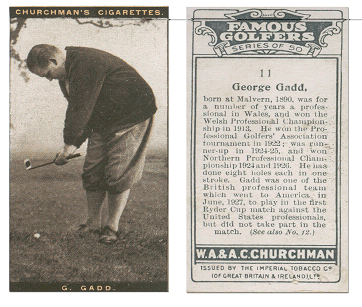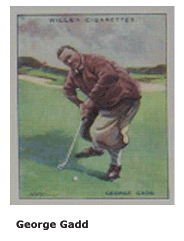|
The
reason given for the decision was that the US team was not
representative, having too many players who were born overseas, but
Golf Illustrated revealed that Ryder had already decided to withhold
the Cup for 12 months; Owing to the uncertainty of the situation
following the General Strike it was not known how many Americans
would come until a few days before the match. Gold medals were
awarded to the players instead. George’s opponent in the singles was
the famous trick-shot exponent Joe Kirkwood, who was born in
Australia. Golf Illustrated reported that Gadd had played ‘perfect
golf’ in his 8 & 7 victory. In the foursomes he and his great
friend, Arthur Havers - the 1923 Open Champion, beat the strong
American pairing of ‘Wild Bill’ Mehlhorn and Al Watrous.
 A few days later George went up to Formby for the Northern
Professional Championship. In the field were nine of the ten
Americans who were over to play in the Open at nearby Royal Lytham
and St Anne’s, including Kirkwood, Mehlhorn, Watrous and the ‘Ryder
Cup’ team captain, the flamboyant Walter Hagen. He had brought his
own caddie, Macfarlane, who had to carry a bag of 22 clubs, which
none but the strong would attempt to carry twice round a golf
course. (Hagen was paid $500-a-year for each club he carried). He
finished down the field at Formby, but he made the trip worthwhile
by playing in an exhibition match at nearby Southport and Ainsdale
and earning £40 plus £10 expenses. He and fellow American Joe Stein
beat two local amateurs by a ‘dog license’ (7&6). A few days later George went up to Formby for the Northern
Professional Championship. In the field were nine of the ten
Americans who were over to play in the Open at nearby Royal Lytham
and St Anne’s, including Kirkwood, Mehlhorn, Watrous and the ‘Ryder
Cup’ team captain, the flamboyant Walter Hagen. He had brought his
own caddie, Macfarlane, who had to carry a bag of 22 clubs, which
none but the strong would attempt to carry twice round a golf
course. (Hagen was paid $500-a-year for each club he carried). He
finished down the field at Formby, but he made the trip worthwhile
by playing in an exhibition match at nearby Southport and Ainsdale
and earning £40 plus £10 expenses. He and fellow American Joe Stein
beat two local amateurs by a ‘dog license’ (7&6).
Walter was a notoriously bad timekeeper and at Formby he arrived by
taxi to hear his name being called. He attracted the attention of
the starter, dashed into the locker room to change and was allowed
to start. Two other members of the American team were disqualified
for the same offence - Kirkwood and the reigning Open champion, the
émigré Cornishman Jim Barnes.
In the opening round George equalled his own course record of 70,
set in Open qualifying two years earlier, to share the lead with a
local player, Bill Davies, then at Prenton, Birkenhead. Aubrey
Boomer, the twenty-year-old Channel Islander based at St Cloud,
France, was close behind. A few weeks earlier Boomer had won the
Daily Mail £1200 tournament at St Andrews and George had shown good
form when sharing the lead after the first two rounds, but faded
away on the final day when a violent rain storm broke over the Old
Course and disrupted play. On another difficult final day of wind
and rain at Formby it was George who went on to take the Northern
Professional title with a total of 296, despite aggravating an old
ankle injury when he slipped on the clubhouse steps before the final
round. A Surgeon bandaged up the foot and George limped round in 77
for a “gallant victory”, as the Times put it. Sharing second, three shots behind, were Davies, Mehlhorn and Ernest
Whitcombe; Watrous finished well, setting a new Formby record with a
68.
In June regional qualifying for the Open took place for the first
time and George went to Sunningdale, his favourite course (along
with Gleneagles), for the southern region event. He was drawn with
the young Henry Cotton, now setting out on his relentless pursuit of
golf’s greatest championship.
 George had an individual style of putting, (famously adopted by the
American Leo Diegel) with which he gave the ball a confident rap. He
used it to great effect in rounds of 71 and 70 for 141 to qualify in
second place behind one of the greatest ever players of the game,
Bobby Jones, who shot his famous ‘perfect round’: 33-33: 66,
described by Bernard Darwin as the best round of golf ever seen.
Jones added a 68 for 134 to be seven shots clear of George. George had an individual style of putting, (famously adopted by the
American Leo Diegel) with which he gave the ball a confident rap. He
used it to great effect in rounds of 71 and 70 for 141 to qualify in
second place behind one of the greatest ever players of the game,
Bobby Jones, who shot his famous ‘perfect round’: 33-33: 66,
described by Bernard Darwin as the best round of golf ever seen.
Jones added a 68 for 134 to be seven shots clear of George.
The Times reported that George was still limping and looking as
if the game was hard work – “a very courageous as well as skilful
effort”.
NEXT |

 A few days later George went up to Formby for the Northern
Professional Championship. In the field were nine of the ten
Americans who were over to play in the Open at nearby Royal Lytham
and St Anne’s, including Kirkwood, Mehlhorn, Watrous and the ‘Ryder
Cup’ team captain, the flamboyant Walter Hagen. He had brought his
own caddie, Macfarlane, who had to carry a bag of 22 clubs, which
none but the strong would attempt to carry twice round a golf
course. (Hagen was paid $500-a-year for each club he carried). He
finished down the field at Formby, but he made the trip worthwhile
by playing in an exhibition match at nearby Southport and Ainsdale
and earning £40 plus £10 expenses. He and fellow American Joe Stein
beat two local amateurs by a ‘dog license’ (7&6).
A few days later George went up to Formby for the Northern
Professional Championship. In the field were nine of the ten
Americans who were over to play in the Open at nearby Royal Lytham
and St Anne’s, including Kirkwood, Mehlhorn, Watrous and the ‘Ryder
Cup’ team captain, the flamboyant Walter Hagen. He had brought his
own caddie, Macfarlane, who had to carry a bag of 22 clubs, which
none but the strong would attempt to carry twice round a golf
course. (Hagen was paid $500-a-year for each club he carried). He
finished down the field at Formby, but he made the trip worthwhile
by playing in an exhibition match at nearby Southport and Ainsdale
and earning £40 plus £10 expenses. He and fellow American Joe Stein
beat two local amateurs by a ‘dog license’ (7&6).  George had an individual style of putting, (famously adopted by the
American Leo Diegel) with which he gave the ball a confident rap. He
used it to great effect in rounds of 71 and 70 for 141 to qualify in
second place behind one of the greatest ever players of the game,
Bobby Jones, who shot his famous ‘perfect round’: 33-33: 66,
described by Bernard Darwin as the best round of golf ever seen.
Jones added a 68 for 134 to be seven shots clear of George.
George had an individual style of putting, (famously adopted by the
American Leo Diegel) with which he gave the ball a confident rap. He
used it to great effect in rounds of 71 and 70 for 141 to qualify in
second place behind one of the greatest ever players of the game,
Bobby Jones, who shot his famous ‘perfect round’: 33-33: 66,
described by Bernard Darwin as the best round of golf ever seen.
Jones added a 68 for 134 to be seven shots clear of George.